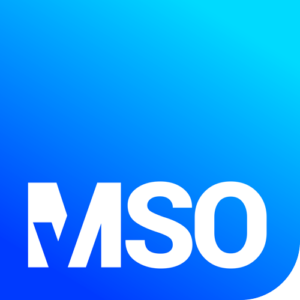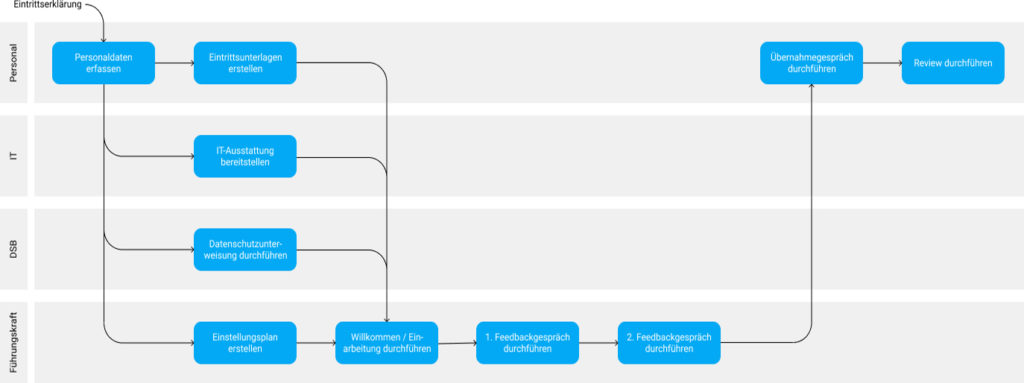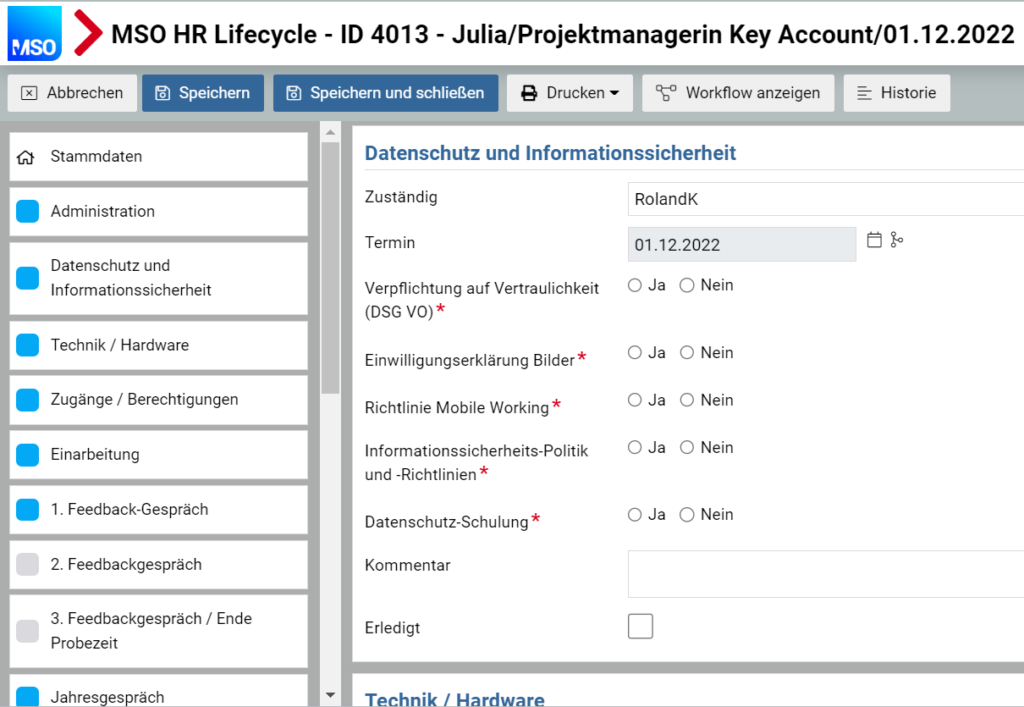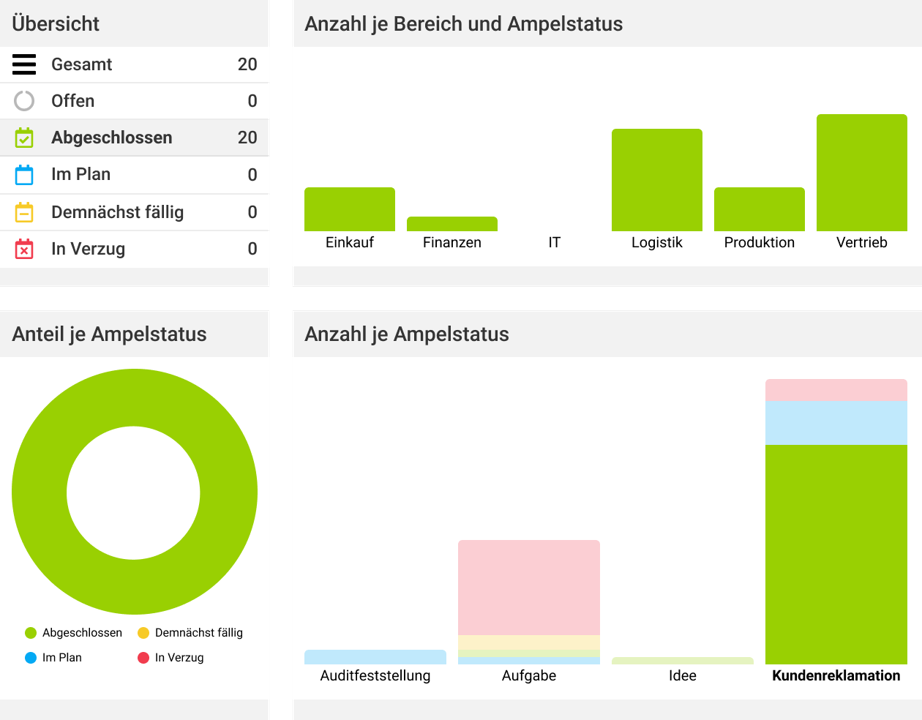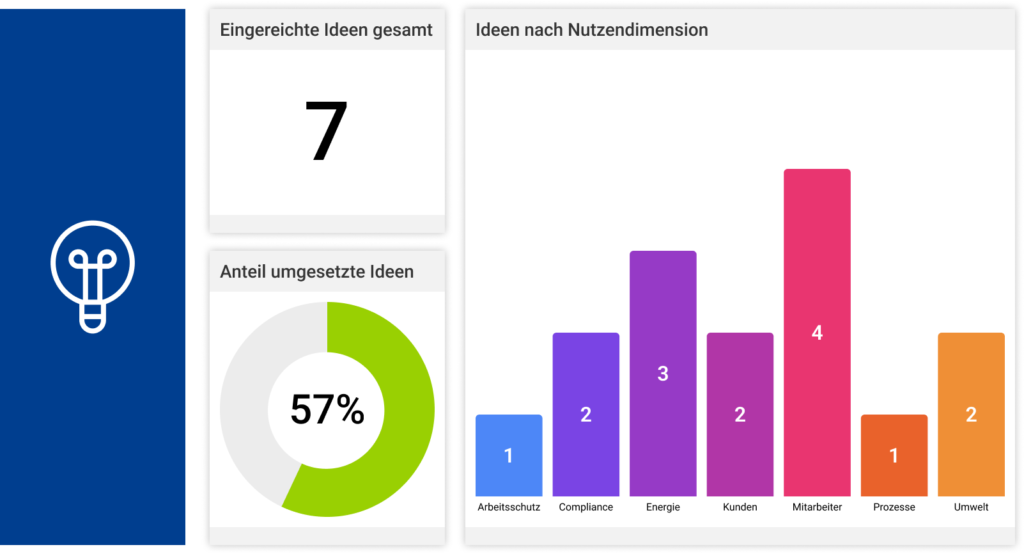Many business processes that still run more or less manually today via Excel, Word, e-mail and the like can be digitized and thus increasingly automated with the use of a workflow tool. This gives companies both a time advantage, because the processes can be run through more quickly and efficiently, and a qualitative advantage through greater transparency, control and compliance.
The term workflow describes how work “flows”, i.e. who carries out a (business) process or a defined sequence of work steps to produce results and when and how.
By first consciously defining workflows, you structure these work steps in terms of their sequence, their interdependencies and their content, thus ensuring that the (recurring) processes are as standardized, comprehensible and efficient as possible.
By digitizing workflows in the second step, the individual steps are run through more or less independently of the process knowledge of the employees involved. A digital workflow means nothing more than mapping the defined work processes digitally. It forms the basis of every standardization and automation of business processes. Basically, every process that runs (or should run) recurrently according to a certain structure or scheme in the company can and should be converted into a digital workflow.
Advantages of a workflow tool
The (hoped-for) advantages of defined workflows in general are obvious: processes follow the same pattern, are accelerated, can be better controlled, deadlines are met and productivity increases.
But is it enough if workflows are processed “manually”? For example, if an employee sends a document to another colleague for familiarization, who forwards it to the next department once the work is done? Is it enough if the task is ticked off in a list and stored on the SharePoint for documentation purposes?
The promised efficiency and quality are lost if data is entered and passed on in many different places and/or no one knows exactly where to find which information and whether it is up-to-date.
- Ensuring and increasing quality
Through the use of templates, defined work steps, defined storage locations and much more. business processes are always adhered to and are less prone to errors.
- Optimizing workflows and increasing efficiency
Fixed guidelines, rules, responsibilities and deadlines ensure shorter waiting times and faster throughput times.
- Improved communication and collaboration
Responsible agents are automatically informed of new tasks as soon as the previous step has been completed. This reduces the amount of unnecessary communication required to obtain information and gives employees more time to complete their tasks.
- Transparency and record keeping
The execution of the processes with all relevant data and information can be queried at the click of a mouse (incl. time stamp for audit-proof logging).
- Compliance
It is ensured that the process steps are carried out as specified and that the execution and approvals are carried out by employees with the appropriate skills and authorizations.
- Evaluability and reporting
The processes can be evaluated in terms of number, runtime and any criteria. The data can be used for continuous improvement.
Challenges when implementing a workflow tool
The existing infrastructure: Before selecting a workflow tool and when using it, the company’s existing infrastructure and existing workflows should be taken into account. There are often already various special solutions and software for various processes or individual tasks. When using a digital workflow tool, interfaces between the individual systems must therefore be enabled or data must initially be imported into the new system. In addition, the workload for internal IT should be kept as low as possible.
Configurability and scalability: Business processes can change regularly, be optimized, other areas are added, new tools need to be integrated, new ideas arise… Digital workflow tools should have the necessary flexibility to always be able to adapt to the requirements of the company and grow with it, so that no discrepancies arise between the real working world and documented workflows.
You can also read more about this in our blog post “Why companies rely on freely configurable and scalable no-code software”.
Which processes can be digitized – where to start?
In a Bitkom study on the “Digitization of [deutschen] Economy” from 2020, the 600 or so companies surveyed only gave themselves a grade of 3-4 when assessing their level of digitalization. Over 90% see digitalization as an opportunity rather than a risk for their company. 48% stated that competitors in their sector who embraced digitalization early on are ahead of them. One in five SMEs does not yet have a digital strategy. It seems that in this area there is still plenty of room for improvement. Even if the advantages of a digital workflow tool are immense, it is certainly hardly feasible and perhaps also not sensible to digitize all workflows in the company in one fell swoop.
Business processes vary in their degree of digitalization, differ in their simplicity or complexity, are costly and time-consuming in different ways and have different priorities. Last but not least, a “digital sweep” could also scare off employees.
Which processes are therefore suitable best resp. As is so often the case, the first step here is to gain an overview by analyzing the current situation of all business processes in the company (where is the greatest potential for improvement?), then set goals (TARGET) and achieve these using a structured approach or pursue the digital strategy step by step throughout the entire company.
First digital business processes can be:
- Employee onboarding: Recording personnel data, drawing up the employment contract and signing it, depending on the date of entry procurement of work equipment, setting up an IT account, sending information, instruction on data protection, occupational safety, induction, feedback interviews, takeover after the probationary period, personnel development…
- Employee resignation/offboarding: letter of resignation, return of work equipment, deregistration of IT and access systems, deregistration of social insurance, issuing of a reference…
- Investment request: Application, justification, classification (cost centers, …), depending on scope and authorization with single or multi-level approval, recording of actual expenditure, evaluations (budget planning, total budget by period, budget status, …)
- Quotation creation: Request entry, request clarification, feasibility check by the specialist departments, calculation, approval, quotation creation, review, approval, follow-up. Evaluation of sales funnel: Number of offers, offer volume, weighted/unweighted, orders by number, by volume, by product groups, regions, customers…
- Order processing: Order entry, order verification, order clarification, order confirmation, order processing according to order schedule, invoicing…
Processes to be digitized should be clearly defined and worked out in the first step before they are digitized. Otherwise, they can only be transferred to a workflow tool with difficulty or there is a discrepancy between the real working world and documented workflows.
The process experts at MSO can help you in terms of process design, process optimization (in terms of results and performance), process KPIs, and process performance. results and performance), process KPIs and controlling as well as process digitalization and automation.
Intuitive workflow design with MSO
With just a few clicks, workflows can be created and edited, calculations can be performed for individual status steps, documents can be uploaded, progress and responsibilities can be tracked transparently and relevant evaluations can be called up with just one click and filtered as required.
Learn more here more about process and workflow management with MSO.
With MSO provides organisations with a fully web-based solution that offers maximum workflow management flexibility. Here, the management software is to be understood as a framework, which is easily configurable and scalable for different company sizes and purposes.
Individual configurability goes hand in hand with intuitive operation and workflow design. Thanks to No-Code approach, adjustments can always be made without much effort and without involving internal IT.

